University of Northampton: Social Responsibility Essay
VerifiedAdded on 2023/01/13
|10
|2619
|93
Essay
AI Summary
This essay examines the social responsibility of businesses, exploring the debate around whether a business's primary focus should be on increasing profits. The essay analyzes various aspects of corporate social responsibility (CSR), including ethical conduct, sustainability, and stakeholder engagement. It uses contrasting theories, such as Carroll's model and Stakeholder theory, to illustrate different approaches to CSR. Several examples of companies, including Equinix and Nisa, are used to demonstrate how businesses implement CSR initiatives and the impact of these initiatives on their operations and public image. The essay also covers ethical and sustainability considerations, including the importance of integrating CSR into a company's overall strategy. The conclusion summarizes the importance of integrating corporate social responsibility in a company.
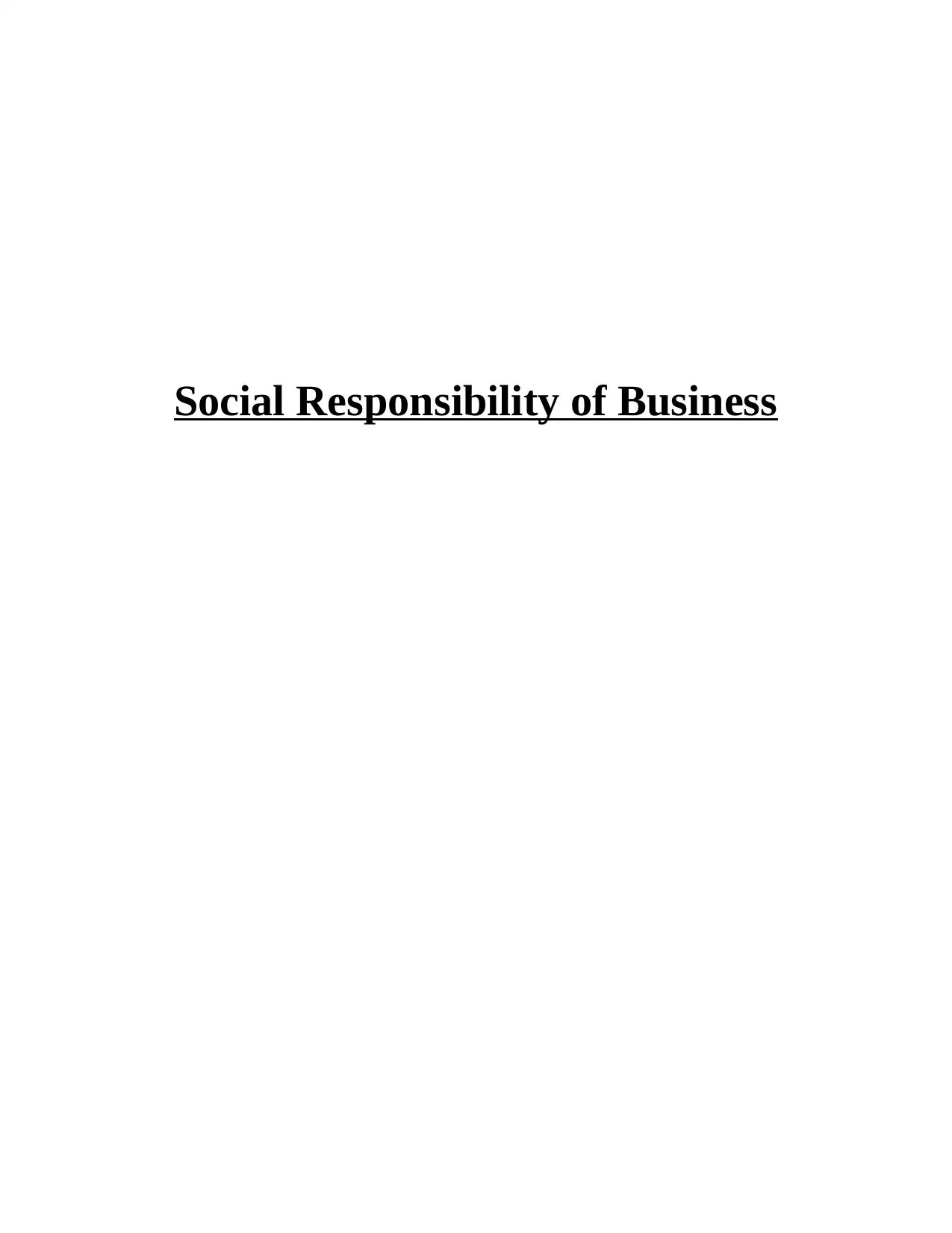
Social Responsibility of Business
Paraphrase This Document
Need a fresh take? Get an instant paraphrase of this document with our AI Paraphraser
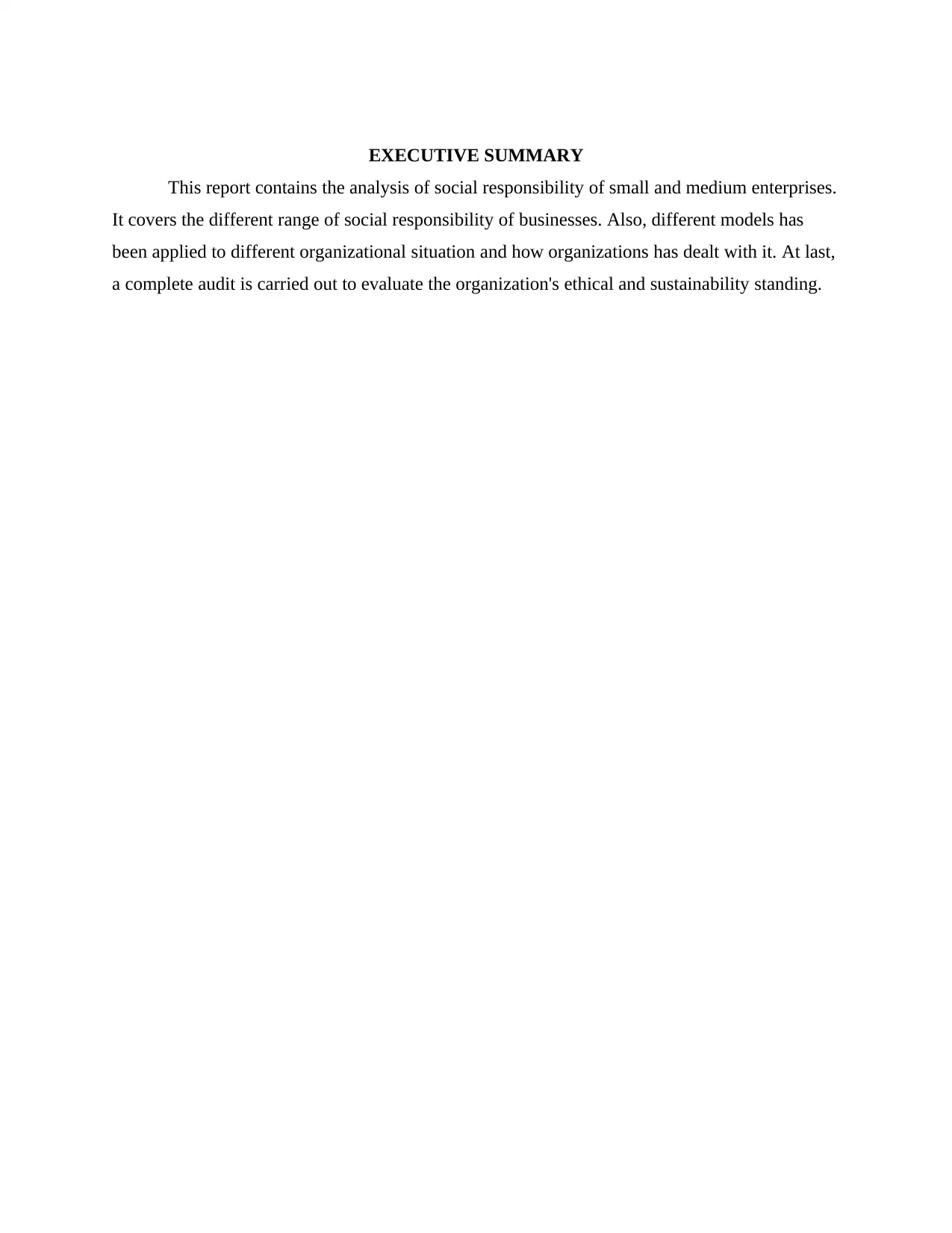
EXECUTIVE SUMMARY
This report contains the analysis of social responsibility of small and medium enterprises.
It covers the different range of social responsibility of businesses. Also, different models has
been applied to different organizational situation and how organizations has dealt with it. At last,
a complete audit is carried out to evaluate the organization's ethical and sustainability standing.
This report contains the analysis of social responsibility of small and medium enterprises.
It covers the different range of social responsibility of businesses. Also, different models has
been applied to different organizational situation and how organizations has dealt with it. At last,
a complete audit is carried out to evaluate the organization's ethical and sustainability standing.
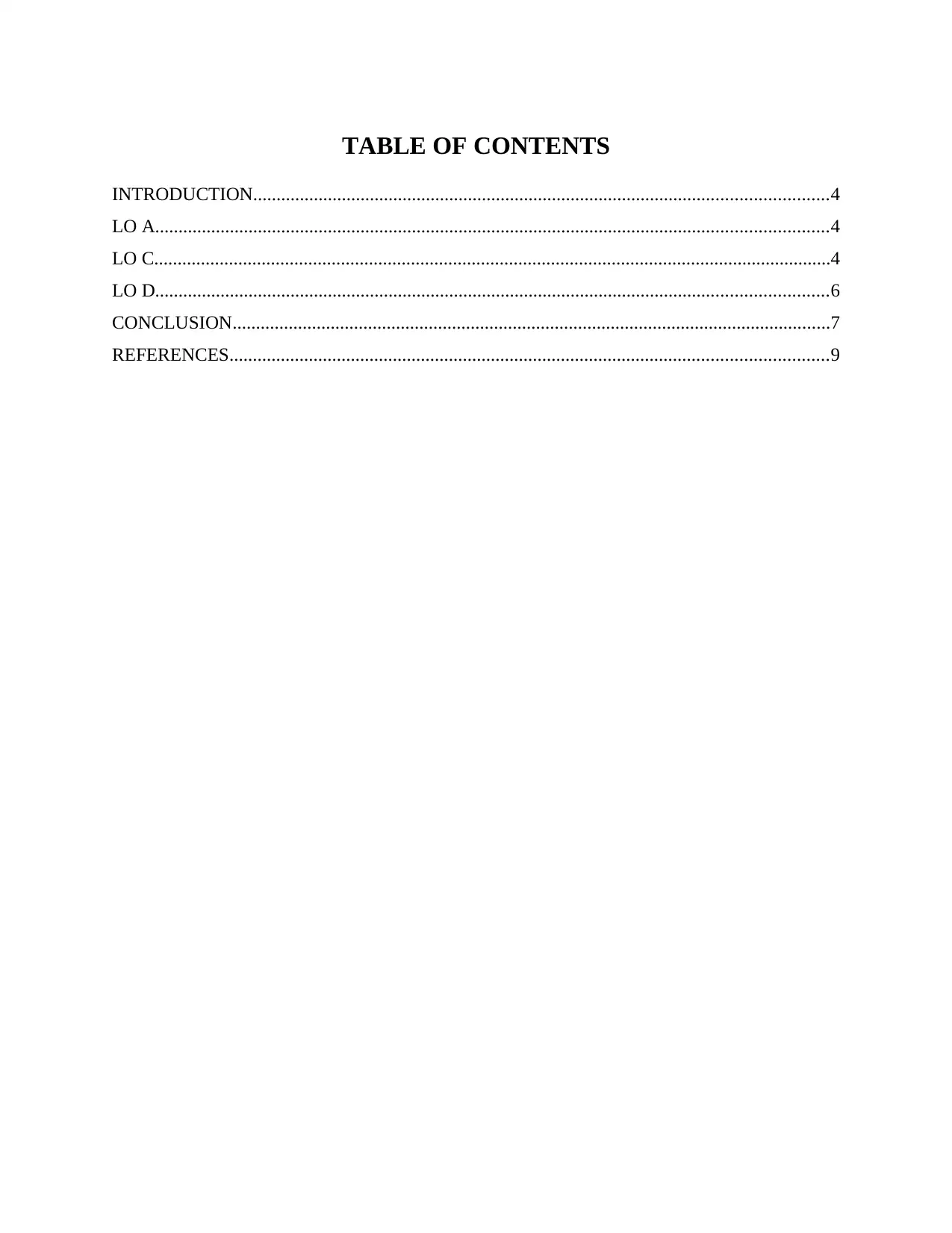
TABLE OF CONTENTS
INTRODUCTION...........................................................................................................................4
LO A................................................................................................................................................4
LO C.................................................................................................................................................4
LO D................................................................................................................................................6
CONCLUSION................................................................................................................................7
REFERENCES................................................................................................................................9
INTRODUCTION...........................................................................................................................4
LO A................................................................................................................................................4
LO C.................................................................................................................................................4
LO D................................................................................................................................................6
CONCLUSION................................................................................................................................7
REFERENCES................................................................................................................................9
⊘ This is a preview!⊘
Do you want full access?
Subscribe today to unlock all pages.

Trusted by 1+ million students worldwide
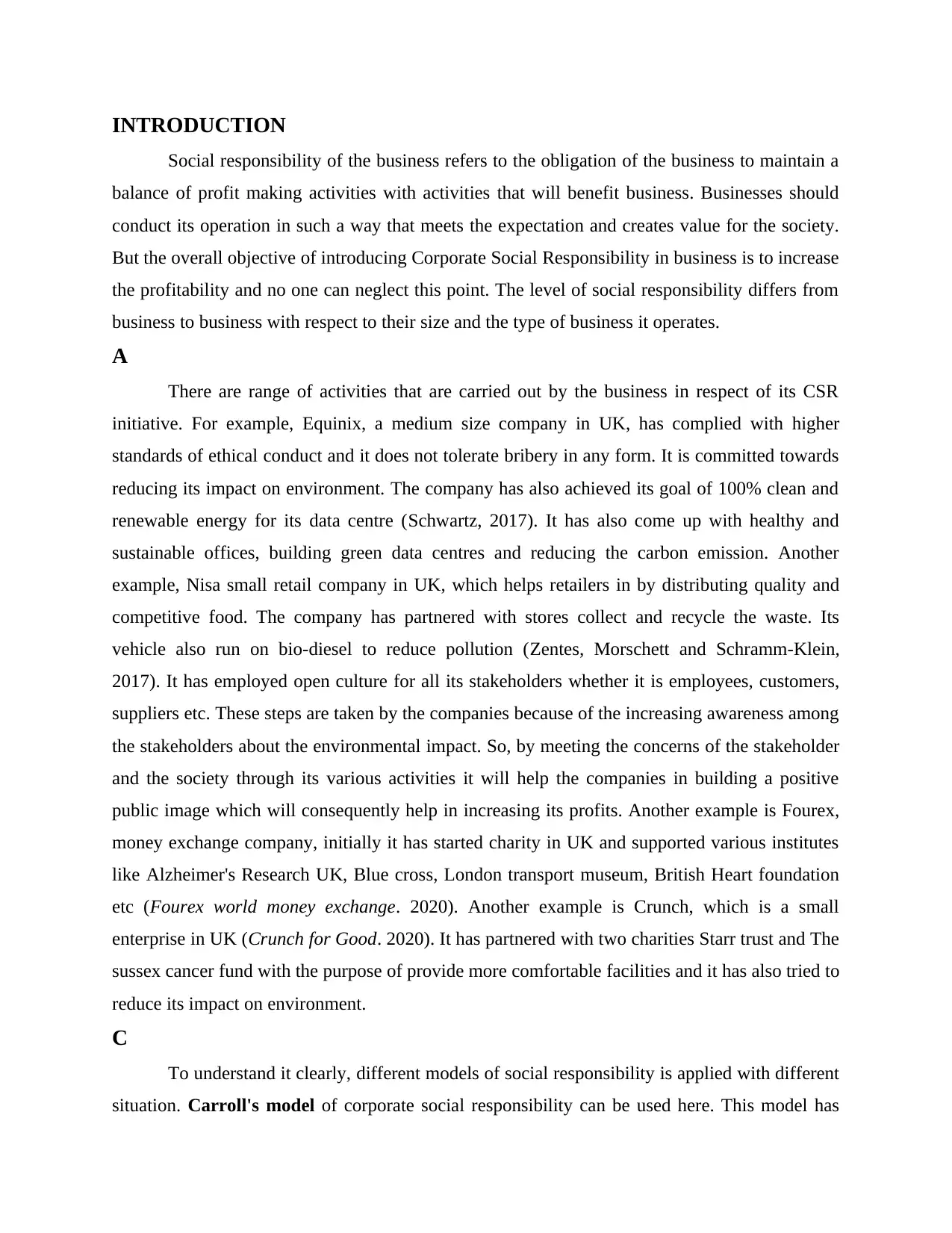
INTRODUCTION
Social responsibility of the business refers to the obligation of the business to maintain a
balance of profit making activities with activities that will benefit business. Businesses should
conduct its operation in such a way that meets the expectation and creates value for the society.
But the overall objective of introducing Corporate Social Responsibility in business is to increase
the profitability and no one can neglect this point. The level of social responsibility differs from
business to business with respect to their size and the type of business it operates.
A
There are range of activities that are carried out by the business in respect of its CSR
initiative. For example, Equinix, a medium size company in UK, has complied with higher
standards of ethical conduct and it does not tolerate bribery in any form. It is committed towards
reducing its impact on environment. The company has also achieved its goal of 100% clean and
renewable energy for its data centre (Schwartz, 2017). It has also come up with healthy and
sustainable offices, building green data centres and reducing the carbon emission. Another
example, Nisa small retail company in UK, which helps retailers in by distributing quality and
competitive food. The company has partnered with stores collect and recycle the waste. Its
vehicle also run on bio-diesel to reduce pollution (Zentes, Morschett and Schramm-Klein,
2017). It has employed open culture for all its stakeholders whether it is employees, customers,
suppliers etc. These steps are taken by the companies because of the increasing awareness among
the stakeholders about the environmental impact. So, by meeting the concerns of the stakeholder
and the society through its various activities it will help the companies in building a positive
public image which will consequently help in increasing its profits. Another example is Fourex,
money exchange company, initially it has started charity in UK and supported various institutes
like Alzheimer's Research UK, Blue cross, London transport museum, British Heart foundation
etc (Fourex world money exchange. 2020). Another example is Crunch, which is a small
enterprise in UK (Crunch for Good. 2020). It has partnered with two charities Starr trust and The
sussex cancer fund with the purpose of provide more comfortable facilities and it has also tried to
reduce its impact on environment.
C
To understand it clearly, different models of social responsibility is applied with different
situation. Carroll's model of corporate social responsibility can be used here. This model has
Social responsibility of the business refers to the obligation of the business to maintain a
balance of profit making activities with activities that will benefit business. Businesses should
conduct its operation in such a way that meets the expectation and creates value for the society.
But the overall objective of introducing Corporate Social Responsibility in business is to increase
the profitability and no one can neglect this point. The level of social responsibility differs from
business to business with respect to their size and the type of business it operates.
A
There are range of activities that are carried out by the business in respect of its CSR
initiative. For example, Equinix, a medium size company in UK, has complied with higher
standards of ethical conduct and it does not tolerate bribery in any form. It is committed towards
reducing its impact on environment. The company has also achieved its goal of 100% clean and
renewable energy for its data centre (Schwartz, 2017). It has also come up with healthy and
sustainable offices, building green data centres and reducing the carbon emission. Another
example, Nisa small retail company in UK, which helps retailers in by distributing quality and
competitive food. The company has partnered with stores collect and recycle the waste. Its
vehicle also run on bio-diesel to reduce pollution (Zentes, Morschett and Schramm-Klein,
2017). It has employed open culture for all its stakeholders whether it is employees, customers,
suppliers etc. These steps are taken by the companies because of the increasing awareness among
the stakeholders about the environmental impact. So, by meeting the concerns of the stakeholder
and the society through its various activities it will help the companies in building a positive
public image which will consequently help in increasing its profits. Another example is Fourex,
money exchange company, initially it has started charity in UK and supported various institutes
like Alzheimer's Research UK, Blue cross, London transport museum, British Heart foundation
etc (Fourex world money exchange. 2020). Another example is Crunch, which is a small
enterprise in UK (Crunch for Good. 2020). It has partnered with two charities Starr trust and The
sussex cancer fund with the purpose of provide more comfortable facilities and it has also tried to
reduce its impact on environment.
C
To understand it clearly, different models of social responsibility is applied with different
situation. Carroll's model of corporate social responsibility can be used here. This model has
Paraphrase This Document
Need a fresh take? Get an instant paraphrase of this document with our AI Paraphraser
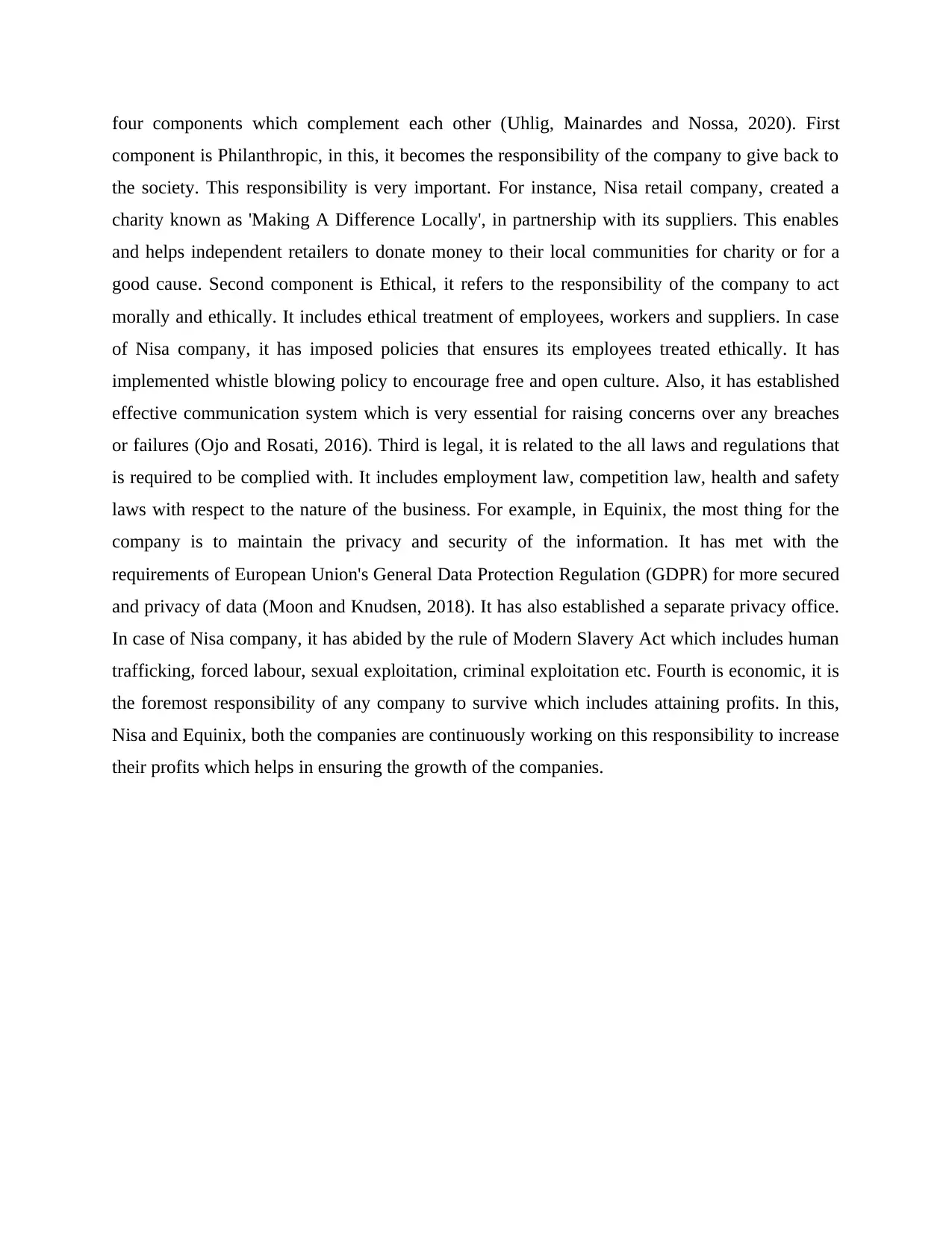
four components which complement each other (Uhlig, Mainardes and Nossa, 2020). First
component is Philanthropic, in this, it becomes the responsibility of the company to give back to
the society. This responsibility is very important. For instance, Nisa retail company, created a
charity known as 'Making A Difference Locally', in partnership with its suppliers. This enables
and helps independent retailers to donate money to their local communities for charity or for a
good cause. Second component is Ethical, it refers to the responsibility of the company to act
morally and ethically. It includes ethical treatment of employees, workers and suppliers. In case
of Nisa company, it has imposed policies that ensures its employees treated ethically. It has
implemented whistle blowing policy to encourage free and open culture. Also, it has established
effective communication system which is very essential for raising concerns over any breaches
or failures (Ojo and Rosati, 2016). Third is legal, it is related to the all laws and regulations that
is required to be complied with. It includes employment law, competition law, health and safety
laws with respect to the nature of the business. For example, in Equinix, the most thing for the
company is to maintain the privacy and security of the information. It has met with the
requirements of European Union's General Data Protection Regulation (GDPR) for more secured
and privacy of data (Moon and Knudsen, 2018). It has also established a separate privacy office.
In case of Nisa company, it has abided by the rule of Modern Slavery Act which includes human
trafficking, forced labour, sexual exploitation, criminal exploitation etc. Fourth is economic, it is
the foremost responsibility of any company to survive which includes attaining profits. In this,
Nisa and Equinix, both the companies are continuously working on this responsibility to increase
their profits which helps in ensuring the growth of the companies.
component is Philanthropic, in this, it becomes the responsibility of the company to give back to
the society. This responsibility is very important. For instance, Nisa retail company, created a
charity known as 'Making A Difference Locally', in partnership with its suppliers. This enables
and helps independent retailers to donate money to their local communities for charity or for a
good cause. Second component is Ethical, it refers to the responsibility of the company to act
morally and ethically. It includes ethical treatment of employees, workers and suppliers. In case
of Nisa company, it has imposed policies that ensures its employees treated ethically. It has
implemented whistle blowing policy to encourage free and open culture. Also, it has established
effective communication system which is very essential for raising concerns over any breaches
or failures (Ojo and Rosati, 2016). Third is legal, it is related to the all laws and regulations that
is required to be complied with. It includes employment law, competition law, health and safety
laws with respect to the nature of the business. For example, in Equinix, the most thing for the
company is to maintain the privacy and security of the information. It has met with the
requirements of European Union's General Data Protection Regulation (GDPR) for more secured
and privacy of data (Moon and Knudsen, 2018). It has also established a separate privacy office.
In case of Nisa company, it has abided by the rule of Modern Slavery Act which includes human
trafficking, forced labour, sexual exploitation, criminal exploitation etc. Fourth is economic, it is
the foremost responsibility of any company to survive which includes attaining profits. In this,
Nisa and Equinix, both the companies are continuously working on this responsibility to increase
their profits which helps in ensuring the growth of the companies.
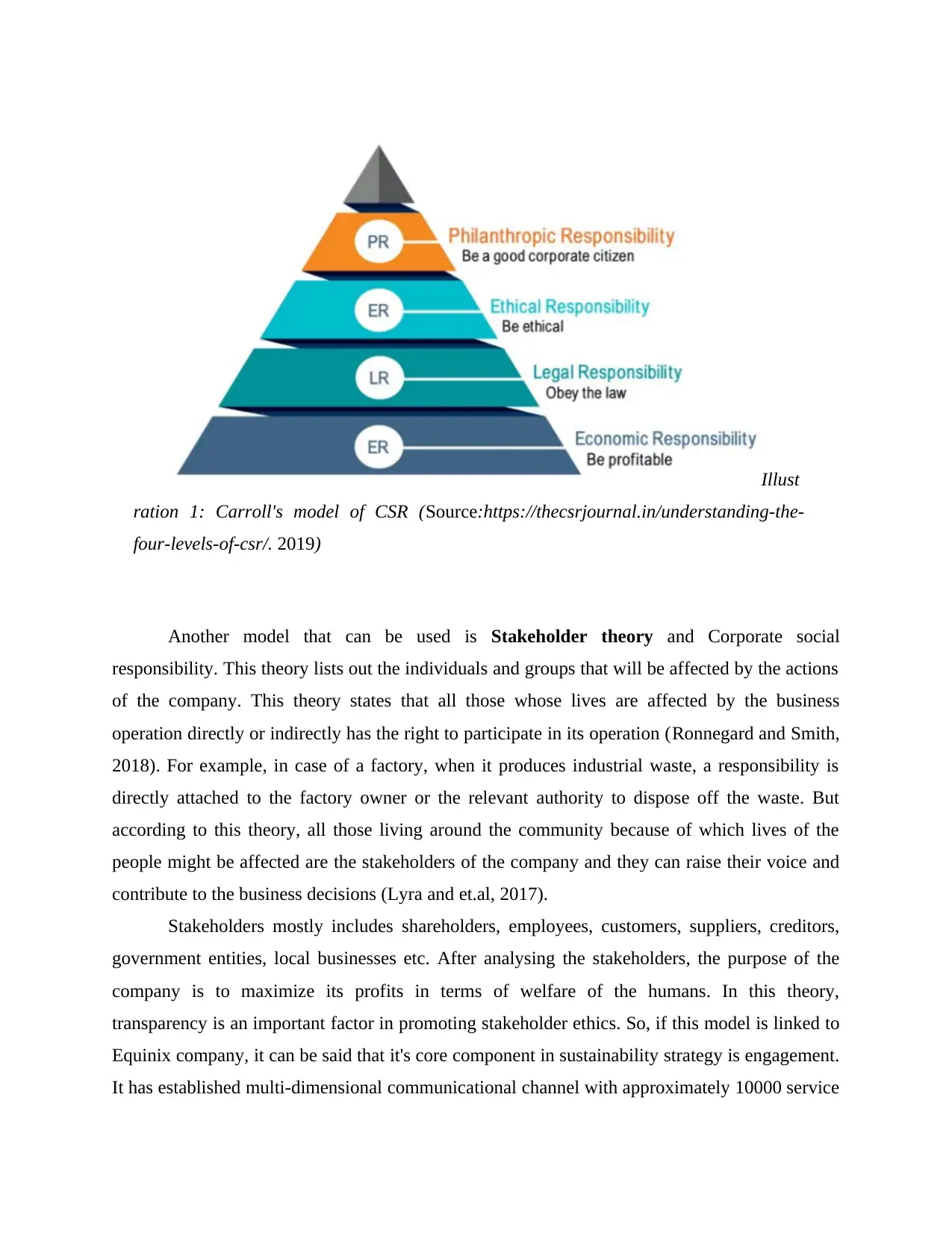
Another model that can be used is Stakeholder theory and Corporate social
responsibility. This theory lists out the individuals and groups that will be affected by the actions
of the company. This theory states that all those whose lives are affected by the business
operation directly or indirectly has the right to participate in its operation (Ronnegard and Smith,
2018). For example, in case of a factory, when it produces industrial waste, a responsibility is
directly attached to the factory owner or the relevant authority to dispose off the waste. But
according to this theory, all those living around the community because of which lives of the
people might be affected are the stakeholders of the company and they can raise their voice and
contribute to the business decisions (Lyra and et.al, 2017).
Stakeholders mostly includes shareholders, employees, customers, suppliers, creditors,
government entities, local businesses etc. After analysing the stakeholders, the purpose of the
company is to maximize its profits in terms of welfare of the humans. In this theory,
transparency is an important factor in promoting stakeholder ethics. So, if this model is linked to
Equinix company, it can be said that it's core component in sustainability strategy is engagement.
It has established multi-dimensional communicational channel with approximately 10000 service
Illust
ration 1: Carroll's model of CSR (Source:https://thecsrjournal.in/understanding-the-
four-levels-of-csr/. 2019)
responsibility. This theory lists out the individuals and groups that will be affected by the actions
of the company. This theory states that all those whose lives are affected by the business
operation directly or indirectly has the right to participate in its operation (Ronnegard and Smith,
2018). For example, in case of a factory, when it produces industrial waste, a responsibility is
directly attached to the factory owner or the relevant authority to dispose off the waste. But
according to this theory, all those living around the community because of which lives of the
people might be affected are the stakeholders of the company and they can raise their voice and
contribute to the business decisions (Lyra and et.al, 2017).
Stakeholders mostly includes shareholders, employees, customers, suppliers, creditors,
government entities, local businesses etc. After analysing the stakeholders, the purpose of the
company is to maximize its profits in terms of welfare of the humans. In this theory,
transparency is an important factor in promoting stakeholder ethics. So, if this model is linked to
Equinix company, it can be said that it's core component in sustainability strategy is engagement.
It has established multi-dimensional communicational channel with approximately 10000 service
Illust
ration 1: Carroll's model of CSR (Source:https://thecsrjournal.in/understanding-the-
four-levels-of-csr/. 2019)
⊘ This is a preview!⊘
Do you want full access?
Subscribe today to unlock all pages.

Trusted by 1+ million students worldwide
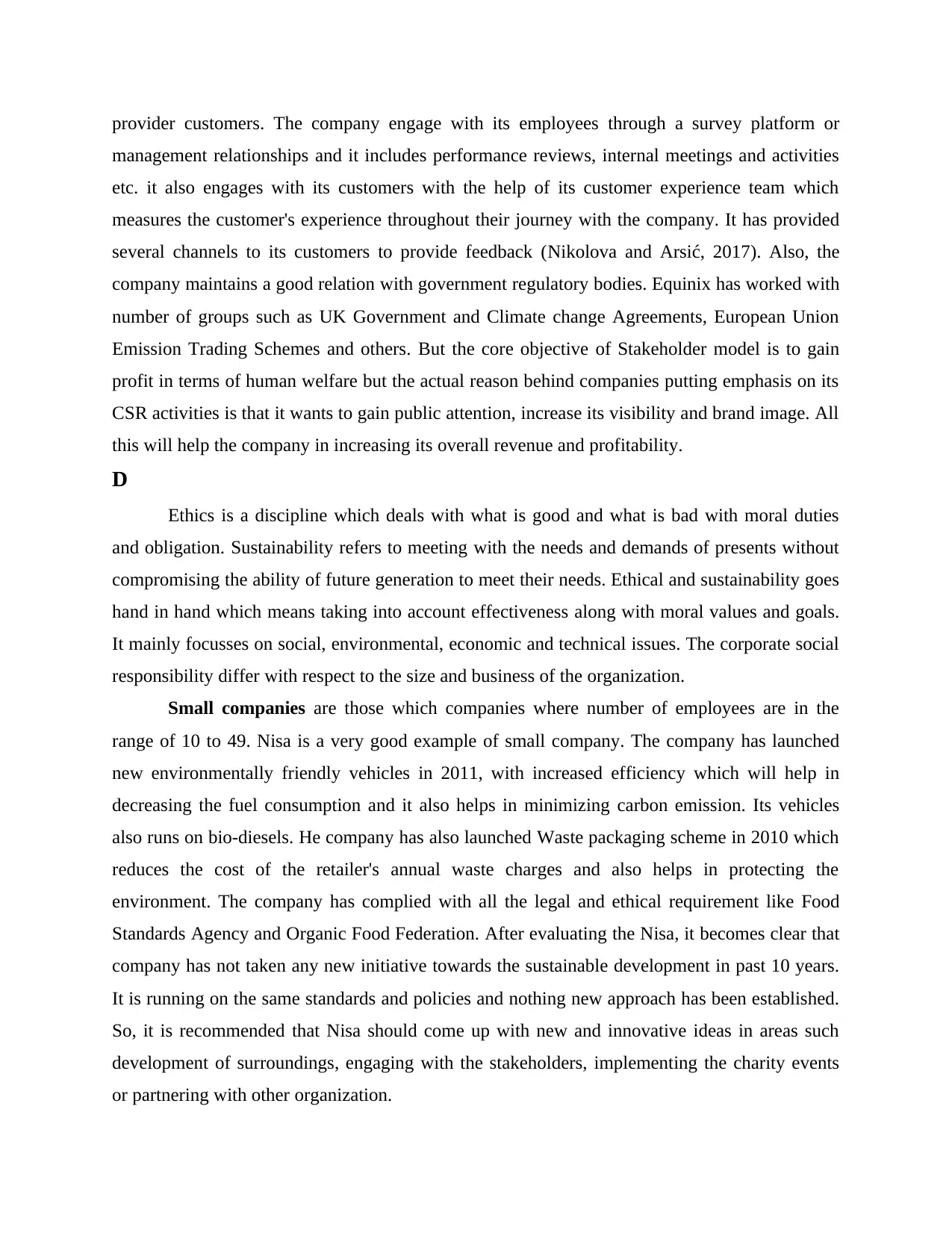
provider customers. The company engage with its employees through a survey platform or
management relationships and it includes performance reviews, internal meetings and activities
etc. it also engages with its customers with the help of its customer experience team which
measures the customer's experience throughout their journey with the company. It has provided
several channels to its customers to provide feedback (Nikolova and Arsić, 2017). Also, the
company maintains a good relation with government regulatory bodies. Equinix has worked with
number of groups such as UK Government and Climate change Agreements, European Union
Emission Trading Schemes and others. But the core objective of Stakeholder model is to gain
profit in terms of human welfare but the actual reason behind companies putting emphasis on its
CSR activities is that it wants to gain public attention, increase its visibility and brand image. All
this will help the company in increasing its overall revenue and profitability.
D
Ethics is a discipline which deals with what is good and what is bad with moral duties
and obligation. Sustainability refers to meeting with the needs and demands of presents without
compromising the ability of future generation to meet their needs. Ethical and sustainability goes
hand in hand which means taking into account effectiveness along with moral values and goals.
It mainly focusses on social, environmental, economic and technical issues. The corporate social
responsibility differ with respect to the size and business of the organization.
Small companies are those which companies where number of employees are in the
range of 10 to 49. Nisa is a very good example of small company. The company has launched
new environmentally friendly vehicles in 2011, with increased efficiency which will help in
decreasing the fuel consumption and it also helps in minimizing carbon emission. Its vehicles
also runs on bio-diesels. He company has also launched Waste packaging scheme in 2010 which
reduces the cost of the retailer's annual waste charges and also helps in protecting the
environment. The company has complied with all the legal and ethical requirement like Food
Standards Agency and Organic Food Federation. After evaluating the Nisa, it becomes clear that
company has not taken any new initiative towards the sustainable development in past 10 years.
It is running on the same standards and policies and nothing new approach has been established.
So, it is recommended that Nisa should come up with new and innovative ideas in areas such
development of surroundings, engaging with the stakeholders, implementing the charity events
or partnering with other organization.
management relationships and it includes performance reviews, internal meetings and activities
etc. it also engages with its customers with the help of its customer experience team which
measures the customer's experience throughout their journey with the company. It has provided
several channels to its customers to provide feedback (Nikolova and Arsić, 2017). Also, the
company maintains a good relation with government regulatory bodies. Equinix has worked with
number of groups such as UK Government and Climate change Agreements, European Union
Emission Trading Schemes and others. But the core objective of Stakeholder model is to gain
profit in terms of human welfare but the actual reason behind companies putting emphasis on its
CSR activities is that it wants to gain public attention, increase its visibility and brand image. All
this will help the company in increasing its overall revenue and profitability.
D
Ethics is a discipline which deals with what is good and what is bad with moral duties
and obligation. Sustainability refers to meeting with the needs and demands of presents without
compromising the ability of future generation to meet their needs. Ethical and sustainability goes
hand in hand which means taking into account effectiveness along with moral values and goals.
It mainly focusses on social, environmental, economic and technical issues. The corporate social
responsibility differ with respect to the size and business of the organization.
Small companies are those which companies where number of employees are in the
range of 10 to 49. Nisa is a very good example of small company. The company has launched
new environmentally friendly vehicles in 2011, with increased efficiency which will help in
decreasing the fuel consumption and it also helps in minimizing carbon emission. Its vehicles
also runs on bio-diesels. He company has also launched Waste packaging scheme in 2010 which
reduces the cost of the retailer's annual waste charges and also helps in protecting the
environment. The company has complied with all the legal and ethical requirement like Food
Standards Agency and Organic Food Federation. After evaluating the Nisa, it becomes clear that
company has not taken any new initiative towards the sustainable development in past 10 years.
It is running on the same standards and policies and nothing new approach has been established.
So, it is recommended that Nisa should come up with new and innovative ideas in areas such
development of surroundings, engaging with the stakeholders, implementing the charity events
or partnering with other organization.
Paraphrase This Document
Need a fresh take? Get an instant paraphrase of this document with our AI Paraphraser
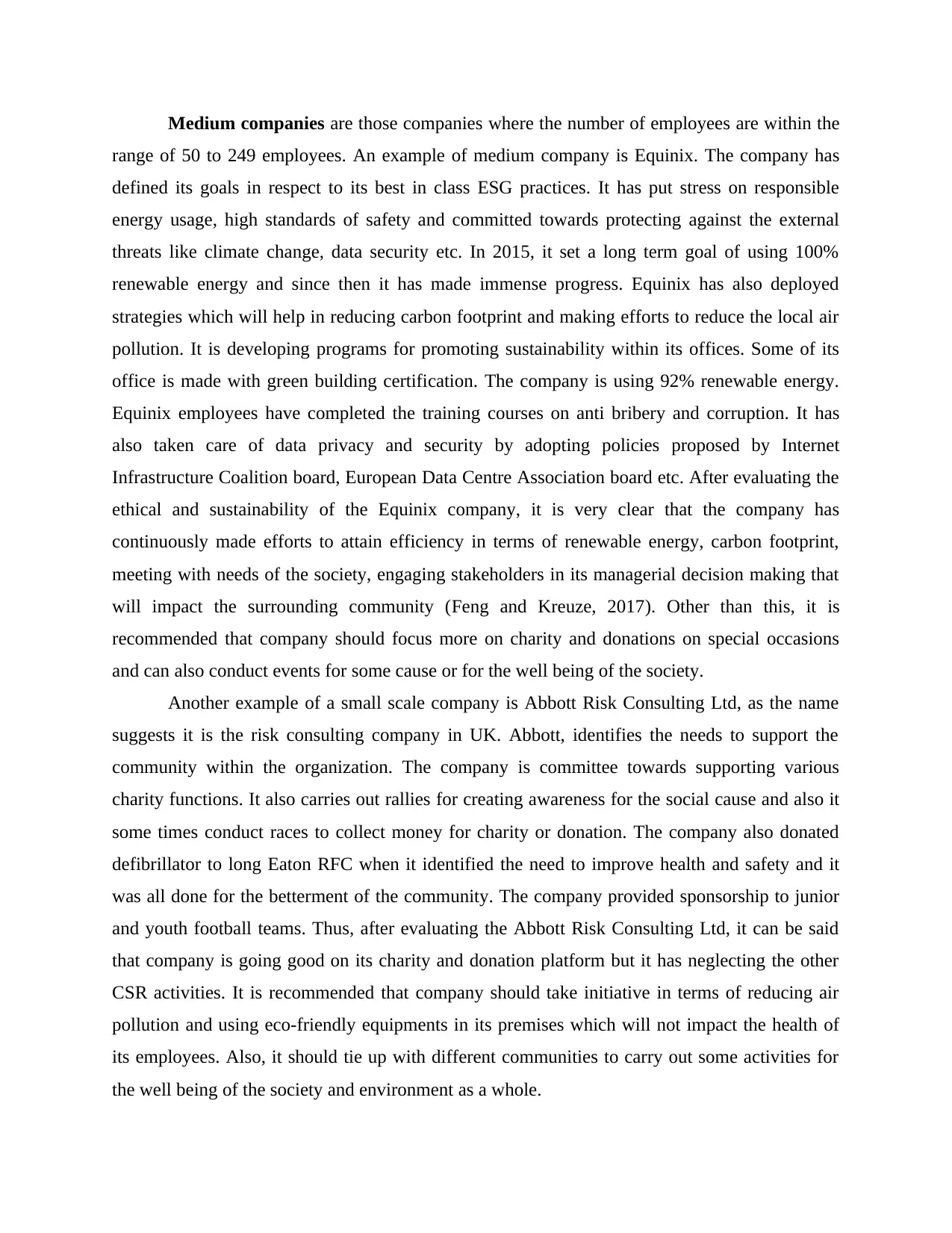
Medium companies are those companies where the number of employees are within the
range of 50 to 249 employees. An example of medium company is Equinix. The company has
defined its goals in respect to its best in class ESG practices. It has put stress on responsible
energy usage, high standards of safety and committed towards protecting against the external
threats like climate change, data security etc. In 2015, it set a long term goal of using 100%
renewable energy and since then it has made immense progress. Equinix has also deployed
strategies which will help in reducing carbon footprint and making efforts to reduce the local air
pollution. It is developing programs for promoting sustainability within its offices. Some of its
office is made with green building certification. The company is using 92% renewable energy.
Equinix employees have completed the training courses on anti bribery and corruption. It has
also taken care of data privacy and security by adopting policies proposed by Internet
Infrastructure Coalition board, European Data Centre Association board etc. After evaluating the
ethical and sustainability of the Equinix company, it is very clear that the company has
continuously made efforts to attain efficiency in terms of renewable energy, carbon footprint,
meeting with needs of the society, engaging stakeholders in its managerial decision making that
will impact the surrounding community (Feng and Kreuze, 2017). Other than this, it is
recommended that company should focus more on charity and donations on special occasions
and can also conduct events for some cause or for the well being of the society.
Another example of a small scale company is Abbott Risk Consulting Ltd, as the name
suggests it is the risk consulting company in UK. Abbott, identifies the needs to support the
community within the organization. The company is committee towards supporting various
charity functions. It also carries out rallies for creating awareness for the social cause and also it
some times conduct races to collect money for charity or donation. The company also donated
defibrillator to long Eaton RFC when it identified the need to improve health and safety and it
was all done for the betterment of the community. The company provided sponsorship to junior
and youth football teams. Thus, after evaluating the Abbott Risk Consulting Ltd, it can be said
that company is going good on its charity and donation platform but it has neglecting the other
CSR activities. It is recommended that company should take initiative in terms of reducing air
pollution and using eco-friendly equipments in its premises which will not impact the health of
its employees. Also, it should tie up with different communities to carry out some activities for
the well being of the society and environment as a whole.
range of 50 to 249 employees. An example of medium company is Equinix. The company has
defined its goals in respect to its best in class ESG practices. It has put stress on responsible
energy usage, high standards of safety and committed towards protecting against the external
threats like climate change, data security etc. In 2015, it set a long term goal of using 100%
renewable energy and since then it has made immense progress. Equinix has also deployed
strategies which will help in reducing carbon footprint and making efforts to reduce the local air
pollution. It is developing programs for promoting sustainability within its offices. Some of its
office is made with green building certification. The company is using 92% renewable energy.
Equinix employees have completed the training courses on anti bribery and corruption. It has
also taken care of data privacy and security by adopting policies proposed by Internet
Infrastructure Coalition board, European Data Centre Association board etc. After evaluating the
ethical and sustainability of the Equinix company, it is very clear that the company has
continuously made efforts to attain efficiency in terms of renewable energy, carbon footprint,
meeting with needs of the society, engaging stakeholders in its managerial decision making that
will impact the surrounding community (Feng and Kreuze, 2017). Other than this, it is
recommended that company should focus more on charity and donations on special occasions
and can also conduct events for some cause or for the well being of the society.
Another example of a small scale company is Abbott Risk Consulting Ltd, as the name
suggests it is the risk consulting company in UK. Abbott, identifies the needs to support the
community within the organization. The company is committee towards supporting various
charity functions. It also carries out rallies for creating awareness for the social cause and also it
some times conduct races to collect money for charity or donation. The company also donated
defibrillator to long Eaton RFC when it identified the need to improve health and safety and it
was all done for the betterment of the community. The company provided sponsorship to junior
and youth football teams. Thus, after evaluating the Abbott Risk Consulting Ltd, it can be said
that company is going good on its charity and donation platform but it has neglecting the other
CSR activities. It is recommended that company should take initiative in terms of reducing air
pollution and using eco-friendly equipments in its premises which will not impact the health of
its employees. Also, it should tie up with different communities to carry out some activities for
the well being of the society and environment as a whole.
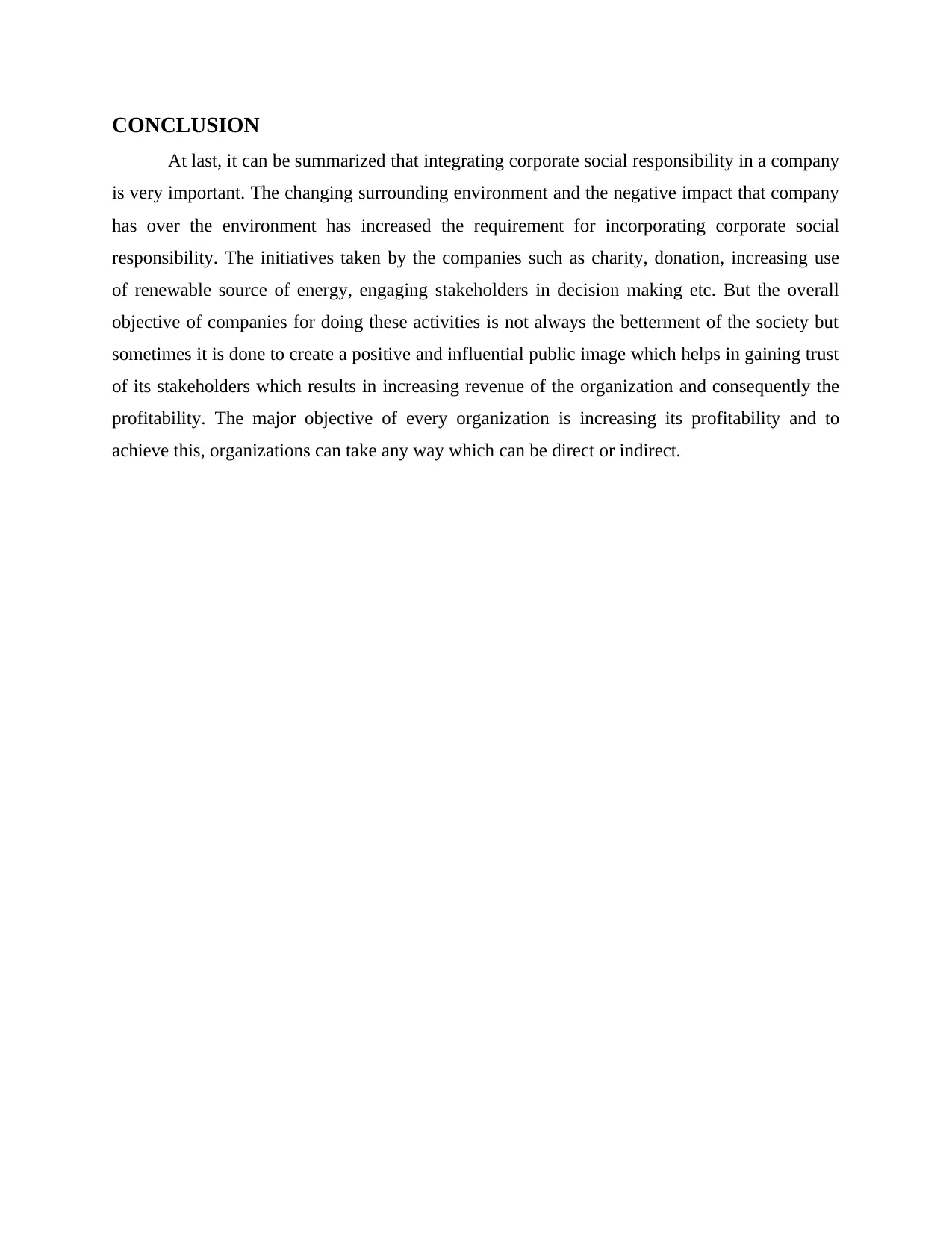
CONCLUSION
At last, it can be summarized that integrating corporate social responsibility in a company
is very important. The changing surrounding environment and the negative impact that company
has over the environment has increased the requirement for incorporating corporate social
responsibility. The initiatives taken by the companies such as charity, donation, increasing use
of renewable source of energy, engaging stakeholders in decision making etc. But the overall
objective of companies for doing these activities is not always the betterment of the society but
sometimes it is done to create a positive and influential public image which helps in gaining trust
of its stakeholders which results in increasing revenue of the organization and consequently the
profitability. The major objective of every organization is increasing its profitability and to
achieve this, organizations can take any way which can be direct or indirect.
At last, it can be summarized that integrating corporate social responsibility in a company
is very important. The changing surrounding environment and the negative impact that company
has over the environment has increased the requirement for incorporating corporate social
responsibility. The initiatives taken by the companies such as charity, donation, increasing use
of renewable source of energy, engaging stakeholders in decision making etc. But the overall
objective of companies for doing these activities is not always the betterment of the society but
sometimes it is done to create a positive and influential public image which helps in gaining trust
of its stakeholders which results in increasing revenue of the organization and consequently the
profitability. The major objective of every organization is increasing its profitability and to
achieve this, organizations can take any way which can be direct or indirect.
⊘ This is a preview!⊘
Do you want full access?
Subscribe today to unlock all pages.

Trusted by 1+ million students worldwide
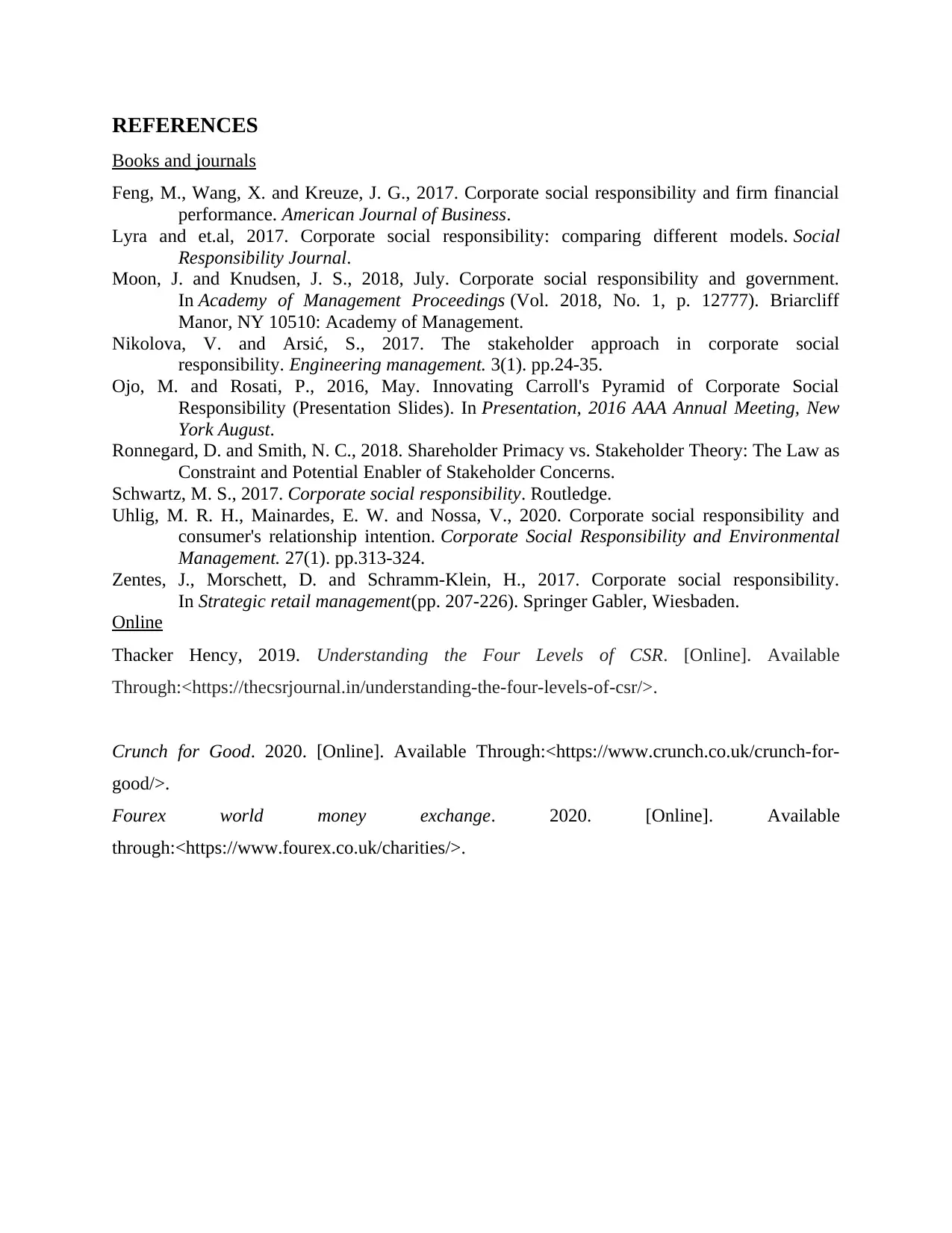
REFERENCES
Books and journals
Feng, M., Wang, X. and Kreuze, J. G., 2017. Corporate social responsibility and firm financial
performance. American Journal of Business.
Lyra and et.al, 2017. Corporate social responsibility: comparing different models. Social
Responsibility Journal.
Moon, J. and Knudsen, J. S., 2018, July. Corporate social responsibility and government.
In Academy of Management Proceedings (Vol. 2018, No. 1, p. 12777). Briarcliff
Manor, NY 10510: Academy of Management.
Nikolova, V. and Arsić, S., 2017. The stakeholder approach in corporate social
responsibility. Engineering management. 3(1). pp.24-35.
Ojo, M. and Rosati, P., 2016, May. Innovating Carroll's Pyramid of Corporate Social
Responsibility (Presentation Slides). In Presentation, 2016 AAA Annual Meeting, New
York August.
Ronnegard, D. and Smith, N. C., 2018. Shareholder Primacy vs. Stakeholder Theory: The Law as
Constraint and Potential Enabler of Stakeholder Concerns.
Schwartz, M. S., 2017. Corporate social responsibility. Routledge.
Uhlig, M. R. H., Mainardes, E. W. and Nossa, V., 2020. Corporate social responsibility and
consumer's relationship intention. Corporate Social Responsibility and Environmental
Management. 27(1). pp.313-324.
Zentes, J., Morschett, D. and Schramm-Klein, H., 2017. Corporate social responsibility.
In Strategic retail management(pp. 207-226). Springer Gabler, Wiesbaden.
Online
Thacker Hency, 2019. Understanding the Four Levels of CSR. [Online]. Available
Through:<https://thecsrjournal.in/understanding-the-four-levels-of-csr/>.
Crunch for Good. 2020. [Online]. Available Through:<https://www.crunch.co.uk/crunch-for-
good/>.
Fourex world money exchange. 2020. [Online]. Available
through:<https://www.fourex.co.uk/charities/>.
Books and journals
Feng, M., Wang, X. and Kreuze, J. G., 2017. Corporate social responsibility and firm financial
performance. American Journal of Business.
Lyra and et.al, 2017. Corporate social responsibility: comparing different models. Social
Responsibility Journal.
Moon, J. and Knudsen, J. S., 2018, July. Corporate social responsibility and government.
In Academy of Management Proceedings (Vol. 2018, No. 1, p. 12777). Briarcliff
Manor, NY 10510: Academy of Management.
Nikolova, V. and Arsić, S., 2017. The stakeholder approach in corporate social
responsibility. Engineering management. 3(1). pp.24-35.
Ojo, M. and Rosati, P., 2016, May. Innovating Carroll's Pyramid of Corporate Social
Responsibility (Presentation Slides). In Presentation, 2016 AAA Annual Meeting, New
York August.
Ronnegard, D. and Smith, N. C., 2018. Shareholder Primacy vs. Stakeholder Theory: The Law as
Constraint and Potential Enabler of Stakeholder Concerns.
Schwartz, M. S., 2017. Corporate social responsibility. Routledge.
Uhlig, M. R. H., Mainardes, E. W. and Nossa, V., 2020. Corporate social responsibility and
consumer's relationship intention. Corporate Social Responsibility and Environmental
Management. 27(1). pp.313-324.
Zentes, J., Morschett, D. and Schramm-Klein, H., 2017. Corporate social responsibility.
In Strategic retail management(pp. 207-226). Springer Gabler, Wiesbaden.
Online
Thacker Hency, 2019. Understanding the Four Levels of CSR. [Online]. Available
Through:<https://thecsrjournal.in/understanding-the-four-levels-of-csr/>.
Crunch for Good. 2020. [Online]. Available Through:<https://www.crunch.co.uk/crunch-for-
good/>.
Fourex world money exchange. 2020. [Online]. Available
through:<https://www.fourex.co.uk/charities/>.
1 out of 10
Related Documents
Your All-in-One AI-Powered Toolkit for Academic Success.
+13062052269
info@desklib.com
Available 24*7 on WhatsApp / Email
![[object Object]](/_next/static/media/star-bottom.7253800d.svg)
Unlock your academic potential
Copyright © 2020–2025 A2Z Services. All Rights Reserved. Developed and managed by ZUCOL.





